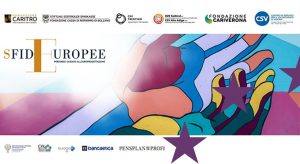-
Introduction to the Guide -
1.0
For orientation -
1.1
What are European projects -
1.2
At the roots of European projects -
1.3
Eurodesign, European institutions and policies -
1.4
Types of European funds and programs -
1.5
Benefit from European projects -
1.6
Overview of European programs 2021-2027 -
2.0
Funding categories 2021-2027 -
2.1
EU programs -
2.2
Structural and rural funds -
2.2.1
ERDF -
2.2.2
ESF+ -
2.2.3
FEAGA -
2.2.4
EAFRD -
2.2.5
FEAMPA -
2.3
Territorial cooperation programs -
3.0
Working on projects -
3.1
Preparing for the project -
3.2
Presenting a project -
3.3
How to structure a project: the process and tools -
3.4
How to structure a project: a practical example and other tools -
3.5
Partnership and collaboration in European projects -
3.6
Managing the project: monitoring and evaluation -
3.7
Reporting in European projects -
3.6
Coming to terms with... -
3.7
Developing and managing a project -
3.0
Getting started... getting to work! -
4.0
Community programs -
4.1
Horizon Europe -
4.2
InvestEU -
4.3
Digital Europe -
4.4
Single Market Program -
4.5
REACT-EU -
4.6
Recovery and resilience device -
4.7
Union Civil Protection Mechanism and RescEU -
4.8
EU4Health -
4.9
Erasmus + -
4.10
European Solidarity Corps -
4.11
Citizenship, equality, rights and values -
4.12
Creative Europe -
4.13
LIFE -
4.14
Mechanism for a just transition -
4.15
Asylum, Migration and Integration Fund -
4.16
Global Europe -
4.17
Humanitarian Aid -
4.18
Euratom -
4.19
ITER -
4.20
Mechanism to connect Europe -
4.21
Anti-fraud program -
4.22
Fiscalis -
4.23
Customs -
4.24
European space program -
4.25
Support for the Turkish Cypriot community -
4.26
Technical support tool -
4.27
Pericles IV -
4.28
Justice -
4.29
Border and visa management tool -
4.30
Instrument for customs control equipment -
4.31
Homeland Security Fund -
4.32
Decommissioning, nuclear safety and decommissioning -
4.33
European Defense Fund -
4.35
Common Foreign and Security Policy -
4.36
Overseas countries and territories -
4.37
Pre-Accession Assistance (IPA III) -
5.0
Structural and rural funds -
5.1
Regional Operating Programs (RP) -
5.1.1
PR Abruzzo -
5.1.2
PR Basilicata -
5.1.3
PR Bolzano -
5.1.4
PR Calabria -
5.1.5
PR Campania -
5.1.6
PR Emilia Romagna -
5.1.7
PR Friuli Venezia Giulia -
5.1.8
PR Lazio -
5.1.9
PR Liguria -
5.1.10
PR Lombardy -
5.1.11
PR Marche -
5.1.12
PR Molise -
5.1.13
PR Piedmont -
5.1.14
PR Apulia -
5.1.15
PR Sardinia -
5.1.6
PR Sicily -
5.1.17
PR Tuscany -
5.1.18
PR Trento -
5.1.19
PR Umbria -
5.1.20
Aosta Valley PR -
5.1.21
PR Veneto -
5.2
National Operational Programs (NOPs) -
5.2.1
PN Capacity for Cohesion -
5.2.2
PN Health equity -
5.2.3
PN Inclusion and poverty alleviation -
5.2.4
PN Metro plus and southern medium cities -
5.2.5
PN School and skills -
5.2.6
PN Culture -
5.2.7
PN Research, innovation and competitiveness for green and digital transition -
5.2.8
PN Security for Lawfulness -
5.2.9
PN Youth, women and work -
5.3
Rural Funds (PSP and CSR) -
5.3.1
CSR Abruzzo -
5.3.2
CSR Basilicata -
5.3.3
CSR Calabria -
5.3.4
CSR Campania -
5.3.5
CSR Emilia-Romagna -
5.3.6
CSR Friuli-Venezia Giulia -
5.3.7
CSR Lazio -
5.3.8
CSR Liguria -
5.3.9
CSR Lombardy -
5.3.10
CSR Marche -
5.3.11
CSR Molise -
5.3.12
CSR PA Bolzano -
5.3.13
CSR PA Trento -
5.3.14
CSR Piedmont -
5.3.15
CSR Apulia -
5.3.16
CSR Sardinia -
5.3.17
CSR Sicily -
5.3.18
CSR Tuscany -
5.3.19
CSR Umbria -
5.3.20
CSR Aosta Valley -
5.3.21
CSR Veneto -
6.0
Territorial cooperation programs -
6.1
Cross-border cooperation -
6.1.1
Italy - Austria -
6.1.2
Italy - Croatia -
6.1.3
Italy - France Maritime -
6.1.4
Italy - Malta -
6.1.5
Italy - Slovenia -
6.1.6
Italy - Switzerland -
6.1.7
France - Italy (ALCOTRA) -
6.1.8
Greece - Italy -
6.1.9
NEXT Italy - Tunisia -
6.1.10
IPA Italy Albania Montenegro (Southern Adriatic) -
6.2
Transnational cooperation -
6.2.1
Alpine Space -
6.2.2
Central Europe -
6.2.3
EURO-MED -
6.2.4
NEXT-MED -
6.2.5
IPA Adriatic-Ionian Sea -
6.3
Interregional cooperation -
6.3.1
ESPON 2030 -
6.3.2
INTERACT -
6.3.3
Interreg Europe -
6.3.4
URBACT IV
Caritro Foundation
3



